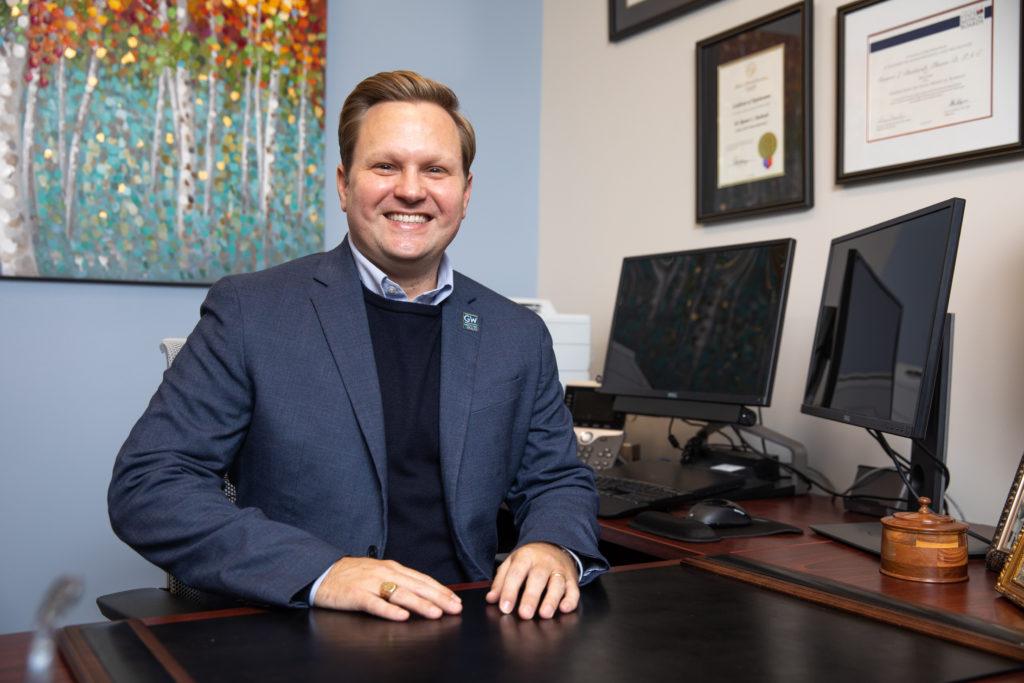A partnership between the School of Medicine and Health Sciences and Virginia-area community colleges has boosted enrollment five years after its implementation, medical school officials said.
The program – which allows students with associate degrees in health sciences to round out their education at the medical school – has increased the diversity of the student body and led to more employment opportunities for students since its 2015 debut, officials said. Reamer Bushardt, the school’s senior associate dean for health sciences, said the transfer program creates a “clear” and “direct” pathway for students to earn advanced professional certifications and degrees.
“Programs like these are part of a larger workforce development initiative focused on careers in health care as well as clinical and translational research,” Bushardt said in an email.
The program guarantees admission to students from nine local community colleges who have completed an associate degree with a cumulative GPA of at least 2.75 and earned a grade of C or higher in transferable coursework, according to the school’s website.
Bushardt said the school maintains “active” transfer agreements with eight DMV-area community colleges like Northern Virginia Community College and the College of Southern Maryland.
He said the transfer program has increased the school’s enrollment over the past five years and that transfer programs have generally gained popularity as health care employers increasingly require more advanced academic qualifications.
Bushardt did not specify how much the program has grown since 2015, but total enrollment in the medical school has increased 15 percent between 2015 and 2019, according to institutional data.
He added that students who transferred to the medical school have increased the diversity of the student body, which “enriches” the experience of other students who can learn from their peers’ varying backgrounds. Bushardt said the transfer program and similar transfer pathways will gradually increase the diversity of the health care workforce because community college students tend to hail from more diverse backgrounds.
“Unfortunately, we have a long way to go in the United States to realize a health workforce and research teams that better reflect the patients, families and communities they exist to serve,” he said. “Health sciences is working to shape a more cutting-edge, diverse workforce.”
Bushardt added that maintaining local partnerships over the past five years has strengthened the medical school’s networking relationships with local higher education institutions and health care providers.
“In addition to growing our student body and enhanced diversity, educational partnerships with community colleges have enabled health sciences to build stronger connections with the community, employers and gain important insights from regional community colleges,” he said.
Bushardt said health sciences faculty received a $3.1 million grant in September 2018 to collaborate with Northern Virginia Community College, Prince George’s Community College and Montgomery College, to provide transfer students advising, mentoring and financial assistance.
“This program is just one example of how university and community college partnerships can benefit society and provide students with unique educational opportunities,” he said.
Bushardt added that medical school officials established the Office of Student Life and Academic Support in Health Sciences “a few years back” to accommodate the academic and personal needs of traditional and transfer students.
He said the school collaborated with Graduate School of Education and Human Development faculty to research factors that “positively” contribute or present obstacles to transfer students’ academic success, then altered the transfer program accordingly.
“We began enriching our student support services to make sure they emphasized the positive factors we had identified and addressed common barriers to student success,” he said.
Higher education experts said the partnership will grant health sciences students opportunities to earn advanced degrees that will make them more competitive job applicants than those who don’t wield degrees.
Amy Getz, the manager for systems implementation for higher education at the University of Texas at Austin, said growing demand for health care workers in the U.S. necessitates that more students can access health sciences education. She said opportunities to attend schools like GW increase opportunities for marginalized communities to begin careers in historically exclusive fields like medicine.
“It’s just really valuable to help our community college populations move into those higher levels of credentials,” Getz said.
Health care provider employment is projected to grow by about 14 percent between 2018 and 2028 in response to increasing demand for health care professionals to care for the aging U.S. population, according to data from the U.S. Bureau of Labor Statistics.
Getz said the medical school partnership allows students to “stack” their credentials or pursue higher degrees without having to retake previously completed community college courses. She said the partnership allows students to easily complete degree programs without paying for courses they have already taken.
“A smooth transfer means that there are fewer credit flaws, and that impacts both the timeliness of completion and also the cost for students,” Getz said.
Whitney Lovelady, the director of the transfer center at Virginia Commonwealth University, said the partnership broadens opportunities for community college students to differentiate themselves to prospective health care employers, who she said are increasingly searching for applicants with advanced degrees.
“Especially with health science programs, it is a booming field that’s not going to be slowing down anytime soon, and we need to encourage our qualified, diverse body of transfer students to apply for those competitive health science programs,” she said.
Krystal Henderson, the program activity manager for the Path program at the San Diego Community College District, said community college transition programs prepare students for the differences in culture and academia between community college and university.
“It’s critical to have support such as these available to community college students because preparing for a transition to a tier-one university can be very challenging,” Henderson said.
Tiffany Garcia contributed reporting.





